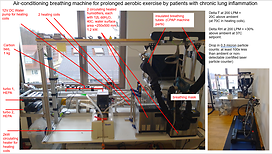Keeping the Weight Down Despite Asthma and Prednisolone
I have poorly controlled asthma, and have to take large quantities of prednisone every couple of months to cope with breathing. This makes it difficult to stay fit, or at least to keep the weight under control.
Exercising with asthma is different
The doctors say that we should exercise, but my response to that is "yeah, right". We all know that every season has something to offer for the asthmatic; it's the cold/dry/smoke-filled air in the winter, and pollen/pollution/ozone in the spring and the summer. Most of my 20 years living with asthma, I've been exercising outdoors in a full 3M respirator (as shown in the avatar pic), and even ran nordic ski marathons in a respirator. But as I get older it gets harder to breathe through the respirator during exercise. In addition, in the winter a respirator offers no protection from the cold/dry air. I further found that gyms have very poor air quality (smell of rubber, dust etc).
How I exercise at home with asthma
So I now mostly exercise at home on bike rollers (Zwift) with a DIY breathing machine. I believe I posted pictures of an early prototype here which I have since improved upon. It's been almost 2 years of me using the machine, and I have had no asthma attacks from it. This is unlike my attempts at outdoor exercise which, on average, have a 10% chance of me having to take prednisolone afterwards, despite a respirator.
The machine supplies the air at adjustable flow of 50-200 liters per minute which roughly matches the intensity. The air is warmed to 37C and is humidified to 70-80% - conditioning which is known to alleviate symptoms of exercise-induced asthma (there are numerous papers on this on pubmed). The air is also purified with two HEPA filters (3M) and with a 1kg charcoal bed. Sensors are used to measure the particulates, temperature, air flow, and humidity of air supplied to the mask. I normally manage 150-200W for 30 min which (according to Zwift anyway) is about 350 kcal burned. This is modest compared to what I could do before asthma (when I raced bikes and marathons), but it does help to keep the weight under control, and the endorphins help, too. It also adds to the safety factor. I know if I start to get sick I can call an ambulance to my flat, rather to some random path in the woods. Well, I never got sick from the machine so far, so that's good.
Improving my at-home exercise routine
In terms of things to improve, I still haven't figured out how to make the machine reduce the flow when I breathe out. Currently, one needs to breathes out against the air flow. It's not too difficult, but it gets old after 30 minutes. I need to implement a valve and a sensor that can divert the air when one breathes out. I have recently received a suggestion from a fellow asthma sufferer to use a scuba valve; will try that.
The next step is to make the machine fit into a backpack, so that I can run or ski with it, if only 15-30 min at a time. I have tried air moisturizing/warming masks; they seem to help a bit, but they do not purify the air.

Join the conversation